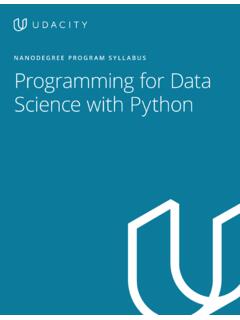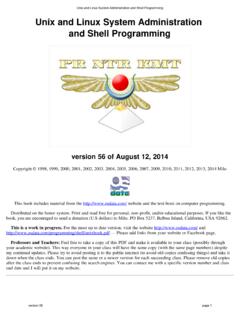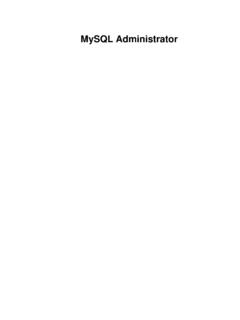Transcription of About the Tutorial
1 PL/SQL i About the Tutorial PL/SQL is a combination of SQL along with the procedural features of programming languages. It was developed by Oracle Corporation in the early 90's to enhance the capabilities of SQL. PL/SQL is one of three key programming languages embedded in the Oracle Database, along with SQL itself and Java. This Tutorial will give you great understanding on PL/SQL to proceed with Oracle database and other advanced RDBMS concepts. Audience This Tutorial is designed for Software Professionals, who are willing to learn PL/SQL Programming Language in simple and easy steps.
2 This Tutorial will give you great understanding on PL/SQL Programming concepts, and after completing this Tutorial , you will be at an intermediate level of expertise from where you can take yourself to a higher level of expertise. Prerequisites Before proceeding with this Tutorial , you should have a basic understanding of software basic concepts like what is database, source code, text editor and execution of programs, etc. If you already have an understanding on SQL and other computer programming language, then it will be an added advantage to proceed.
3 Copyright & Disclaimer Copyright 2018 by tutorials Point (I) Pvt. Ltd. All the content and graphics published in this e-book are the property of tutorials Point (I) Pvt. Ltd. The user of this e-book is prohibited to reuse, retain, copy, distribute or republish any contents or a part of contents of this e-book in any manner without written consent of the publisher. We strive to update the contents of our website and tutorials as timely and as precisely as possible, however, the contents may contain inaccuracies or errors. tutorials Point (I) Pvt.
4 Ltd. provides no guarantee regarding the accuracy, timeliness or completeness of our website or its contents including this Tutorial . If you discover any errors on our website or in this Tutorial , please notify us at PL/SQL ii Table of Contents About the Tutorial .. i Audience .. i Prerequisites .. i Copyright & Disclaimer .. i Table of Contents .. iii PL/SQL OVERVIEW .. 1 Features of PL/SQL .. 1 Advantages of PL/SQL .. 1 PL/SQL ENVIRONMENT SETUP .. 3 Text 14 PL/SQL BASIC SYNTAX .. 15 PL/SQL DATA TYPES .. 19 PL/SQL Scalar Data Types and Subtypes.
5 19 PL/SQL Numeric Data Types and Subtypes .. 20 PL/SQL Character Data Types and Subtypes .. 21 PL/SQL Boolean Data Types .. 22 PL/SQL Datetime and Interval Types .. 22 PL/SQL Large Object (LOB) Data Types .. 23 PL/SQL User-Defined Subtypes .. 24 NULLs in PL/SQL .. 25 PL/SQL VARIABLES .. 26 Variable Declaration in PL/SQL .. 26 Initializing Variables in PL/SQL .. 27 Variable Scope in PL/SQL .. 28 PL/SQL iii Assigning SQL Query Results to PL/SQL Variables .. 29 PL/SQL CONSTANTS AND LITERALS .. 31 Declaring a Constant .. 31 The PL/SQL 32 PL/SQL OPERATORS.
6 34 Arithmetic Operators .. 34 Relational Operators .. 36 [Comparison Operators .. 39 Logical Operators .. 44 PL/SQL Operator Precedence .. 46 PL/SQL CONDITIONS .. 49 IF-THEN Statement .. 50 IF-THEN-ELSE Statement .. 53 IF-THEN-ELSIF Statement .. 55 CASE Statement .. 56 Searched CASE Statement .. 58 Nested IF-THEN-ELSE Statements .. 60 PL/SQL LOOPS .. 62 Basic Loop Statement .. 63 WHILE LOOP Statement .. 65 FOR LOOP Statement .. 66 Reverse FOR LOOP Statement .. 68 Nested Loops .. 69 Labeling a PL/SQL Loop .. 71 The Loop Control Statements .. 72 PL/SQL iv EXIT Statement.]
7 73 The EXIT WHEN Statement .. 75 CONTINUE Statement .. 77 GOTO Statement .. 80 PL/SQL STRINGS .. 83 Declaring String Variables .. 83 PL/SQL String Functions and Operators .. 84 PL/SQL ARRAYS .. 89 Creating a Varray Type .. 89 PL/SQL PROCEDURES .. 94 Parts of a PL/SQL 94 Creating a Procedure .. 95 Executing a Standalone Procedure .. 96 Deleting a Standalone Procedure .. 97 Parameter Modes in PL/SQL Subprograms .. 98 Methods for Passing Parameters .. 100 PL/SQL FUNCTIONS .. 103 Creating a Function .. 103 Calling a Function .. 104 PL/SQL Recursive Functions.
8 106 PL/SQL CURSORS .. 108 Implicit Cursors .. 108 Explicit Cursors .. 110 Declaring the Cursor .. 112 Opening the Cursor .. 112 PL/SQL v Fetching the Cursor .. 112 Closing the Cursor .. 112 PL/SQL RECORDS .. 114 Table-Based Records .. 114 Cursor-Based Records .. 115 User-Defined 116 PL/SQL EXCEPTIONS .. 120 Syntax for Exception Handling .. 120 Raising Exceptions .. 121 User-defined Exceptions .. 122 Pre-defined Exceptions .. 123 PL/SQL TRIGGERS .. 126 Creating Triggers .. 126 Triggering a Trigger .. 129 PL/SQL PACKAGES .. 130 Package Specification.
9 130 Package Body .. 130 Using the Package Elements .. 131 PL/SQL COLLECTIONS .. 138 Index-By Table .. 139 Nested Tables .. 141 Collection Methods .. 144 Collection Exceptions .. 145 PL/SQL vi PL/SQL TRANSACTIONS .. 147 Starting and Ending a Transaction .. 147 Committing a Transaction .. 147 Rolling Back Transactions .. 148 Automatic Transaction Control .. 149 PL/SQL DATE & TIME .. 150 Field Values for Datetime and Interval Data Types .. 150 The Datetime Data Types and Functions .. 151 The Interval Data Types and Functions .. 155 PL/SQL DBMS OUTPUT.
10 157 DBMS_OUTPUT Subprograms .. 157 PL/SQL OBJECT-ORIENTED .. 160 Instantiating an Object .. 161 Member Methods .. 161 Using Map method .. 162 Using Order method .. 164 Inheritance for PL/SQL Objects .. 166 Abstract Objects in PL/SQL .. 168 PL/SQL 7 The PL/SQL programming language was developed by Oracle Corporation in the late 1980s as procedural extension language for SQL and the Oracle relational database. Following are certain notable facts About PL/SQL: PL/SQL is a completely portable, high-performance transaction-processing language. PL/SQL provides a built-in, interpreted and OS independent programming environment.


















